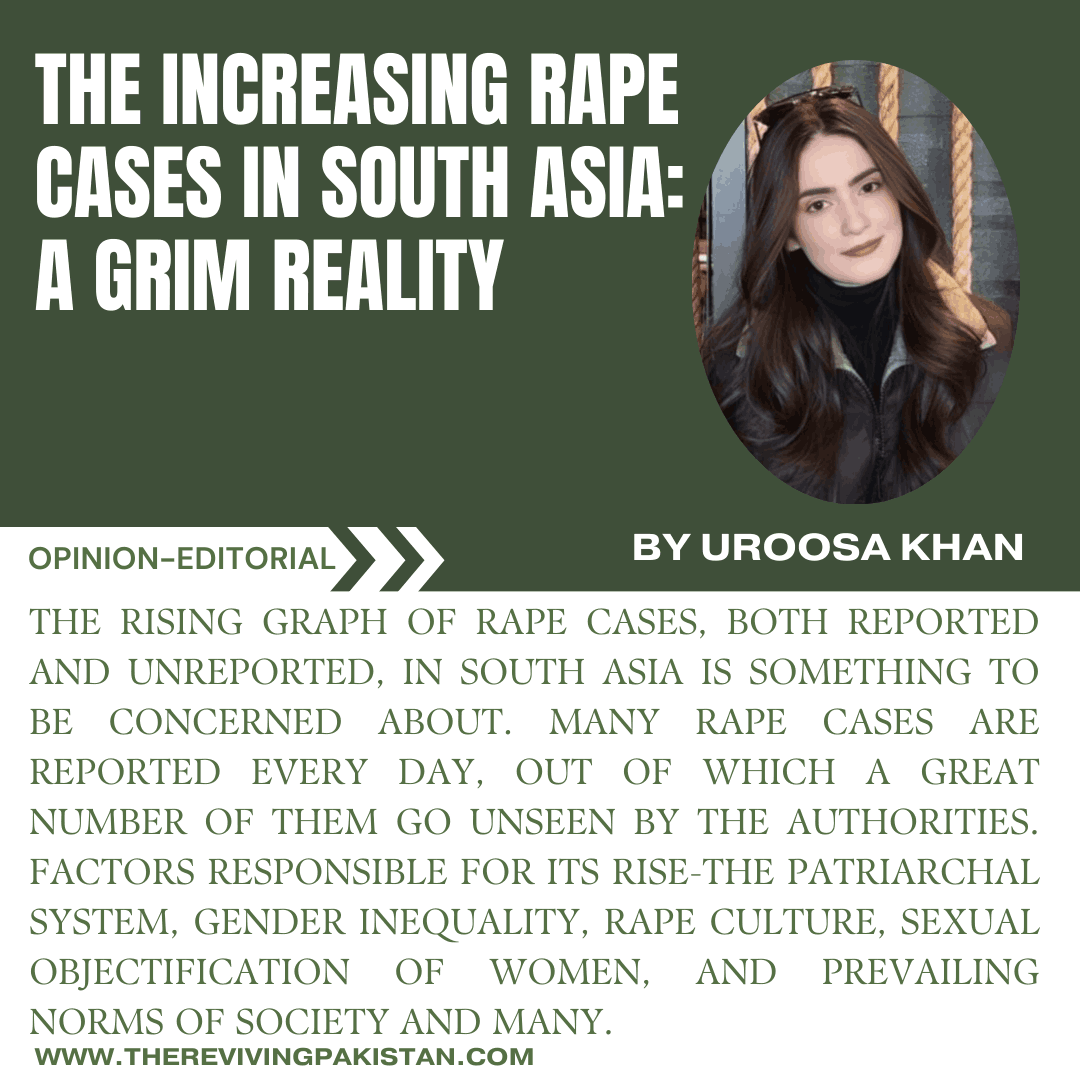About the Author(s)

Uroosa Khan
The author is an independent researcher having keen interest in foreign policy, geopolitics, and international relations.
The rising graph of rape cases, both reported and unreported, in South Asia is something to be concerned about. Many rape cases are reported every day, out of which a great number of them go unseen by the authorities. Factors responsible for its rise-the patriarchal system, gender inequality, rape culture, sexual objectification of women, and prevailing norms of society and many. At every other step, rape culture in the countries of South Asia blames the victim for the rape by passing sexist remarks and judgment. Besides this, loss of state authority, poor law enforcement, low rate of conviction, inefficient judiciary, and elite culture are some other factors that increase the issues.
From the rising rape cases in India to the skyrocketing child rapes in Pakistan, it is not only women but also children who have become the target of rapists. The child rapes in Pakistan have become so frequent that the government has completely failed to ensure safety for women and children, who have fallen prey to those rapists who are running free. The horrific pictures and videos of the victims are circulated on social media to show the extent of the heinous crime.
Also, the issue is further perpetuated by the Madonna-Whore Complex-a psychological concept wherein women are viewed in terms of duality, meaning either pure and virtuous or impure and licentious. Stemmed from Sigmund Freud’s theory, it has been highly stereotypical; hence, the formation of women as secondary citizens-submissive and passive. To the increased rape incidents, most men blame women, saying that women’s clothes encourage such actions. Such irrational thinking does not explain why minors, as young as four years, become victims of rape, which definitely dispels the belief that clothes are one of the reasons.
It is a pity that society blames the victims and lets the offenders go scot-free. In cases of gang rape or murder shared on social media, little action is taken, and public outrage dies away in no time. All this turns societal apathy into the normalization of brutality, which in turn decreases the likelihood of such heinous acts being combated effectively. The case of rape and sexual violence remains grim in Pakistan. As many as 6,656 cases of rape were reported in 2023, which means an average of 11 rape cases were reported every day. Not even tourists are spared; incidents of bullying, harassment, and gang rape have been reported, further denting the image of the country.
The horrific rape of a female doctor in Kolkata sent Indians onto the streets with full-throated protests against the rape culture that had taken hold of India. On the other hand, Pakistani youth have remained silent as ever. No major rallies are being conducted with strong demands for better enforcement of laws and increasing the conviction rate of criminals. By remaining so idle, the menace is allowed to continue unabated and makes society unsafe for women and children.
Society as a whole has to come forward-both men and women-to fight against this evil. In a male-oriented society, men should actively involve themselves in countering rape culture. A safe environment for women cannot be achieved without solid support from society. Religious leadership is also in an important position. In Pakistan, religion strongly influences every attitude in society, and to that effect, religious scholars can play a significant role by promoting respect for women and discouraging extremist views that place men at the level of masters and women as second-class citizens. However, religious leaders more often than not turn a blind eye, avoiding making comments on this horrific situation: the rape of women and children. Their involvement is needed for real change to take place.
This is a crisis that needs the requisite intervention of parliamentary oversight, whereby political parties in their diversity put aside their differences in the interest of their women and children. In equal measure, civil society organizations are supposed to raise awareness, advocate for policy changes, and support victims. Equally, they need to challenge constructive cultural norms and stereotypes that perpetuate gender-based violence. Education on healthy relationships and sexuality, respect for the other gender, will help break down the old mindset and bring equality between the sexes. Furthermore, engendering a more complex understanding of women-that they can be sexual and respectable-can help lower the rates of all these destructive attitudes and behaviors.
The safety of women is a basic litmus test of integrity in society. A country which fails in protecting its women and children from sexual violence cannot boast itself to be just or civilized. It is now high time all the stakeholders came together-government, religious leaders, civil society, and people-to break the rape culture and build a society in which women and children can live without fear. Only through collective action will we be able to aspire to a secure and equal future for all.

